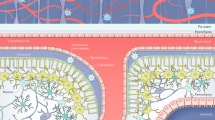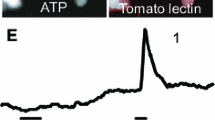Summary
The monoclonal antibody 2F8 was used to localize the macrophage scavenger receptor by immunohistochemistry. In control adult mice, macrophage scavenger receptor expression in the brain was restricted to stromal and epiplexus macrophages of the choroid plexus, meningeal macrophages and to perivascular sites. Microglia did not express the receptor. In the developing mouse brain, macrophage scavenger receptor expression was high on meningeal macrophages and detectable on immature microglia in the supraventricular corpus callosum, cingulum, cavum septum and the periaqueductal area. In the aged mouse brain, the pattern of macrophage scavenger receptor expression was no different from that in the young adult brain. Macrophage scavenger receptor expression on resident microglia and recruited macrophages was detected 24 h after an intrahippocampal injection of either lipopolysaccharide or kainic acid. Macrophage scavenger receptor expression was also detected in microglia 3 days after optic nerve crush both in the nerve segment distal to the crush site and in the superior colliculus. These studies indicate a potential role for the macrophage scavenger receptor in the CNS in the clearance of debris during acute neuronal degeneration.
Similar content being viewed by others
References
Andersson, P-B., Perry, V. H. &Gordon, S. (1991) The kinetics and morphological characteristics of the macrophage-microglial response to kainic acid-induced neuronal degeneration.Neuroscience 42, 201–14.
Andersson, P-B., Perry, V. H. &Gordon, S. (1992) The acute inflammatory response to lipopolysaccharide in the CNS parenchyma differs from that of other body tissues.Neuroscience 48, 169–86.
Austyn, J. M. &Gordon, S. (1981) F4/80, a monoclonal antibody directed specifically against the mouse macrophage.European Journal of Immunology 11, 805–15.
Boya, J., Calvo, J. L., Carbonell, A. L. &Borregon, A. (1991) A lectin histochemistry study of rat microglial cells.Journal of Anatomy 175, 229–36.
Brown, M. S. &Goldstein, J. L. (1983) Lipoprotein metabolism in the macrophage: implications for cholesterol deposition in atherosclerosis.Annual Review of Biochemistry 52, 223–61.
Chugani, D. C., Kedersha, N. L. &Rome, L. H. (1991) Vault immunofluorescence in the brain: new insights regarding the origin of microglia.Neuroscience 11, 256–68.
De Groot, C. J., Huppes, W., Sminia, T., Kraal, G. &Dijkstra, C. D. (1992) Determination of the origin and nature of brain macrophages and microglial cells in mouse central nervous system, using non-radioactivein situ hybridisation and immunoperoxidase techniques.Glia 6, 301–9.
Fraser, I., Hughes, D. &Gordon, S. (1993) Divalent cation-independent macrophage adhesion inhibited by monoclonal antibody to murine scavenger receptor.Nature 364, 343–6.
Griffin, J. W., George, R., Lobato, C., Tyor, W. R., Yan, L. C. &Glass, J. D. (1992) Macrophage responses and myelin clearance during Wallerian degeneration: relevance to immune-mediated demyelination.Journal of Neuroimmunology 40, 153–66.
Goldstein, J. L., Ho, Y. K., Basu, S. K. &Brown, M. S. (1979) Binding site on macrophages that mediates uptake and degradation of acetylated low density lipoprotein, producing massive cholesterol deposition.Proceedings of the National Academy of Sciences (USA) 76, 333–7.
Hampton, R. Y., Golenbock, D. T., Penman, M., Krieger, M. &Raetz, C. R. H. (1991) Recognition and clearance of endotoxin by scavenger receptors.Nature 352, 342–4.
Hsu, S. M., Raine, L. &Fanger, H. (1981) The Use of avidin-biotin-peroxidase (ABC) complex in immunoperoxidase techniques: a comparison between ABC and unlabelled antibody (PAP) procedures.Journal of Histochemistry and Cytochemistry 29, 577–80.
Kodama, T., Reddy, P., Kishimoto, C. &Krieger, M. (1988) Purification and characterisation of a bovine acetyl low density lipoprotein receptor.Proceedings of the National Academy of Sciences (USA) 85, 9238–42.
Krieger, M. (1992) Molecular flypaper and atherosclerosis: structure of the macrophage scavenger receptor.Trends in Biological Sciences 17, 141–6.
McLean, I. W. &Nakane, P. K. (1974) Periodate-lysineparaformaldehyde fixative. A new fixative for immunoelectron microscopy.Journal of Histochemistry and Cytochemistry 22, 1077–83.
Milligan, C. E., Cunningham, T. J. &Levitt, P. (1991) Differential immunochemical markers reveal the normal distribution of brain macrophages and microglia in the developing rat brain.Journal of Comparative Neurology 314, 125–35.
Naito, M., Kodama, T., Matsumoto, A., Doi, T. &Takahashi, K. (1991) Tissue distribution, intracellular localisation and in vitro expression of bovine macrophage scavenger receptors.American Journal of Pathology 139, 1411–23.
Oppenheim, R. W. (1981) Studies in developmental neurobiology. In:Essays in honor of Viktor Hamburger (edited byCowan, W. M.). 74–133. New York-Oxford: Oxford University Press.
Perry, V. H. &Gordon, S. (1991) Macrophages and the nervous system.International Review of Cytology 125, 203–44.
Perry, V. H., Hume, D. A. &Gordon, S. (1985) Immunohistochemical localisation of macrophages and microglia in the adult and developing mouse brain.Neuroscience 15, 313–26.
Perry, V. H., Brown, M. C. &Gordon, S. (1987) The macrophage response to central and peripheral nerve injury.Journal of Experimental Medicine 165, 1218–23.
Perry, V. H., Matyszak, M. K. &Fearn, S. (1993) Altered antigen expression of microglia in the aged rodent CNS.Glia 7, 60–7.
Peters, A., Josephson, K. &Vincent, S. L. (1991) Effects of ageing on the neuroglial cells and pericytes within area 17 of the rhesus monkey cerebral cortex.Anatomical Record 229, 384–98.
Rosen, H. &Gordon, S. (1987) Monoclonal antibody to the murine type 3 complement receptor inhibits adhesion of myelomonocytic cellsin vitro and inflammatory cell recruitmentin vivo.Journal of Experimental Medicine 166, 1685–701.
Savill, J. S., Henson, P. M. &Haslett, C. (1989) Phagocytosis of aged human neutrophils by macrophages is mediated by a novel ‘charge-sensitive‘ recognition mechanism.Journal of Clinical Investigation 84, 1518–27.
Savill, J. S., Fadok, V., Henson, P. M. &Haslett, C. (1993) Phagocyte recognition of cells undergoing apoptosis.Immunology Today 14, 131–6.
Schwartz, C. J., Valente, A. J. &Sprague, E. A. (1993) A modern view of atherogenesis.American Journal of Cardiology 71, 9–14B.
Stoll, G., Griffin, J. W., Li, C. Y. &Trapp, B. D. (1989) Wallerian degeneration in the peripheral nervous system: participation of both Schwann cells and macrophages in myelin degradation.Journal of Neurocytology 18, 671–83.
Streit, W. J., Grabber, M. B. &Kreutzberg, G. W. (1988) Functional plasticity of microglia: a review.Glia 1, 301–7.
Uchiyama, J., Kuniki, H., Fujikura, Y., Fukumoto, T. &Koshiro, A. (1991) Analysis of K. pneumoniae by monoclonal antibody: immunohistochemical detection of K. pneumoniae surface antigen injected into mice and rats.Immunobiology 814(1) 63–74.
Ulevitch, R. J. (1993) Recognition of bacterial endotoxins by receptor-dependent mechanisms.Advances in Immunology 53, 267–89.
Vaughan, D. W. &Peters, A. (1974) Neuroglial cells in the cerebral cortex of rats from young adulthood to old age: an electron microscopic study.Journal of Neurocytology 3, 405–29.
Author information
Authors and Affiliations
Rights and permissions
About this article
Cite this article
Bell, M.D., Lopez-Gonzalez, R., Lawson, L. et al. Upregulation of the macrophage scavenger receptor in response to different forms of injury in the CNS. J Neurocytol 23, 605–613 (1994). https://doi.org/10.1007/BF01191555
Received:
Revised:
Accepted:
Issue Date:
DOI: https://doi.org/10.1007/BF01191555




